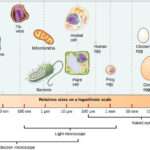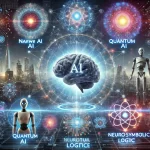
How does bioinformatics connect computer science/IT and biology?
November 24, 2023I. Introduction. Bioinformatics as an Interdisciplinary Field:
- Defining Intersection: Bioinformatics serves as the intersection of computer science/IT and biology, leveraging computational approaches to extract meaningful insights from biological data.
- Collaborative Nature: Recognizing the collaborative nature of bioinformatics, where experts from both computer science and biology come together to tackle the intricacies of biological challenges.
B. Connecting Computer Science/IT and Biology:
- Synergy of Computational Techniques: Delving into the synergy between computational techniques and the analysis of biological data, showcasing how computational tools enhance the understanding of complex biological phenomena.
- Role of Algorithms and Data Structures: Highlighting the pivotal role of algorithms and data structures in bioinformatics, emphasizing their contribution to advancing the comprehension of biological processes.
C. Importance of Collaboration in Advancing Biological Research:
- Significance of Collaboration: Emphasizing the crucial role of collaboration between biologists, bioinformaticians, and computer scientists in driving progress in biological research.
- Enhanced Effectiveness: Illustrating how collaborative approaches enhance the effectiveness of research by combining domain-specific knowledge with computational expertise to address intricate biological questions.
In summary, the introduction sets the stage by defining bioinformatics, exploring the synergy between computer science and biology, and underlining the importance of collaboration for advancing biological research.
II. Foundations of Bioinformatics
- Application of Computational Techniques in Biology:
- Computational biology involves using mathematical and computational methods to analyze biological data. This encompasses a wide range of applications, from sequence analysis to structural biology and systems biology.
- Techniques such as sequence alignment, phylogenetic analysis, and molecular dynamics simulations fall under computational biology.
- Integration of Algorithms and Data Analysis in Biological Research:
- Algorithms play a crucial role in bioinformatics by providing systematic procedures for solving biological problems. Examples include algorithms for sequence alignment, motif discovery, and protein structure prediction.
- Data analysis involves the interpretation of biological data to extract meaningful insights. This can include statistical analysis, machine learning, and visualization techniques.
B. Information Technology in Biology:
- Role of IT Infrastructure in Handling Biological Data:
- As biological data volumes increase, IT infrastructure becomes essential for storage, retrieval, and analysis. High-performance computing and cloud platforms are utilized to handle massive datasets.
- Bioinformatics databases and tools often require robust IT systems to support tasks like genome assembly, variant calling, and large-scale simulations.
- Challenges and Solutions in Managing Big Data in Bioinformatics:
- Challenges include the sheer volume of biological data generated from experiments such as genomics, transcriptomics, and proteomics.
- Solutions involve the development of efficient algorithms, parallel computing, and the use of distributed systems. Additionally, cloud computing provides scalable solutions for handling big data in bioinformatics.
In summary, the foundations of bioinformatics lie in the synergy between computational biology and information technology. Computational techniques and algorithms drive data analysis in various biological domains, while IT infrastructure is crucial for managing and processing the ever-growing biological datasets. Addressing challenges in big data management is a key aspect of ensuring the effective use of bioinformatics in advancing biological research.
III. Computational Methods in Biological Data Analysis
A. Sequence Analysis:
- DNA, RNA, and Protein Sequence Alignment:
- DNA Sequence Alignment: Involves comparing two or more DNA sequences to identify similarities and differences. Algorithms like Smith-Waterman and Needleman-Wunsch are commonly used.
- RNA Sequence Alignment: Similar to DNA alignment but tailored to RNA sequences, considering differences in RNA-specific structures and features.
- Protein Sequence Alignment: A critical task for understanding protein function and evolution. Tools like BLAST and ClustalW align protein sequences based on similarities.
- Algorithms for Identifying Homologous Sequences:
- Homology Search Algorithms: Methods like Basic Local Alignment Search Tool (BLAST) and Hidden Markov Models (HMMs) are employed to identify homologous sequences.
- Phylogenetic Analysis: Utilizes evolutionary information to infer relationships between species or genes. Maximum Likelihood and Neighbor-Joining are common methods.
B. Structural Biology:
- Protein Structure Prediction:
- Homology Modeling: Predicts the 3D structure of a protein based on the known structure of a related protein (template).
- Ab Initio Modeling: Predicts protein structure from scratch without relying on homologous templates.
- Hybrid Methods: Combine aspects of homology modeling and ab initio methods for improved accuracy.
- Molecular Dynamics Simulations:
- Simulating Biomolecular Systems: Molecular dynamics simulations track the movements of atoms and molecules over time, providing insights into the dynamic behavior of biological macromolecules.
- Force Fields: Mathematical models describing the interactions between atoms. Common force fields include AMBER, CHARMM, and GROMOS.
- Applications: Studying protein folding, ligand binding, and conformational changes in biomolecules.
In essence, this section explores the computational methods employed in analyzing biological data, focusing on sequence analysis and structural biology. Sequence alignment is fundamental for understanding genetic relationships, while structural biology techniques such as protein structure prediction and molecular dynamics simulations contribute to deciphering the 3D structures and dynamics of biomolecules.
IV. Data Storage and Management
A. Databases in Bioinformatics:
- Genomic Databases:
- GenBank: A comprehensive database of genetic sequences, including DNA, RNA, and protein sequences.
- Ensembl: Integrates genomic information with annotations, providing a centralized resource for genome data.
- UCSC Genome Browser: Allows visualization and exploration of genomic data for various organisms.
- Integration of Biological Data for Research:
- Bioinformatics Databases: House diverse biological data types, such as genomics, proteomics, and metabolomics data, facilitating interdisciplinary research.
- Data Warehousing: Integration of data from multiple sources, enabling researchers to perform complex analyses and make comprehensive observations.
- Ontologies and Standards: Adoption of standardized terms and formats for data integration, promoting interoperability.
B. Cloud Computing:
- Storing and Analyzing Large-Scale Biological Datasets:
- Scalability: Cloud platforms provide the flexibility to scale up or down based on the computational and storage needs of bioinformatics analyses.
- Data Lakes: Storage solutions for large-scale biological datasets, allowing for efficient retrieval and analysis.
- Data Security: Implementing measures to ensure the security and integrity of sensitive biological data.
- Collaboration and Accessibility in the Cloud:
- Collaborative Workspaces: Cloud environments facilitate collaborative research by providing shared workspaces where researchers can access and analyze data together.
- Accessibility: Cloud-based platforms enhance accessibility to bioinformatics tools and resources, enabling researchers to work from different locations.
- Cost-Efficiency: Cloud computing offers cost-effective solutions for bioinformatics analyses without the need for extensive local infrastructure.
In summary, this section explores the critical aspects of data storage and management in bioinformatics, emphasizing the importance of specialized databases for genomic data and the advantages of leveraging cloud computing for storing, analyzing, and collaborating on large-scale biological datasets.
V. Algorithm Development
A. Computational Algorithms in Biology:
- Phylogenetic Tree Construction:
- Multiple Sequence Alignment: Algorithms like ClustalW and MAFFT align sequences for phylogenetic analysis.
- Neighbor-Joining and Maximum Likelihood Methods: Common approaches for constructing phylogenetic trees.
- Phylogenomic Analysis: Integration of genomic data to enhance the accuracy of phylogenetic trees.
- Machine Learning Applications in Bioinformatics:
- Classification Algorithms: Support Vector Machines (SVM), Random Forest, and Neural Networks for tasks like disease classification based on genomic data.
- Clustering Techniques: K-means clustering and hierarchical clustering for identifying patterns in large biological datasets.
- Predictive Modeling: Regression algorithms used in predicting gene expression levels or protein-protein interactions.
B. Optimization Techniques:
- Maximizing Efficiency in Biological Data Analysis:
- Dynamic Programming: Applied in sequence alignment algorithms to optimize the identification of homologous regions.
- Parallelization: Distributing computational tasks across multiple processors to enhance the speed of analyses.
- Heuristic Approaches: Algorithms like simulated annealing or genetic algorithms for optimizing solutions in complex biological problems.
- Applications in Drug Discovery and Disease Modeling:
- Virtual Screening: Optimization algorithms to identify potential drug candidates through molecular docking simulations.
- Systems Biology Optimization: Applying optimization techniques to model complex biological systems and understand their behavior.
- Personalized Medicine: Optimization approaches in tailoring treatments based on individual genomic profiles.
In essence, this section delves into the realm of algorithm development in bioinformatics, covering the construction of phylogenetic trees, the application of machine learning in diverse biological contexts, and the use of optimization techniques to enhance efficiency in data analysis, particularly in drug discovery and disease modeling.
VI. Bioinformatics Software and Tools
A. Integration of Computer Science Principles:
- Development of User-Friendly Bioinformatics Tools:
- Graphical User Interfaces (GUIs): Integration of intuitive interfaces for users with limited programming skills.
- Workflow Visualization: Tools like Taverna and Galaxy providing visual representations of bioinformatics workflows.
- User-Centric Design: Emphasizing accessibility and ease of use to cater to a broad audience of researchers and biologists.
- Open-Source Software for the Scientific Community:
- Community-Driven Development: Involvement of the scientific community in the collaborative development of bioinformatics tools.
- Version Control Systems: Utilization of systems like Git for tracking changes and maintaining transparency.
- Licensing Models: Adoption of open-source licenses (e.g., GNU General Public License) to encourage collaboration and sharing.
In this section, the focus is on the integration of computer science principles in bioinformatics software development. This includes the design of user-friendly tools through GUIs and workflow visualization, as well as the promotion of open-source practices to foster collaboration and community-driven development within the scientific community.
VII. Systems Biology
A. Modeling Biological Systems:
- Computational Approaches to Understand Biological Networks:
- Network Reconstruction: Utilization of data-driven methods to infer biological interactions within cellular systems.
- Pathway Analysis: Identification and analysis of biological pathways using computational tools.
- Constraint-Based Modeling: Employing mathematical models to simulate and analyze cellular processes under specific constraints.
- Predictive Modeling for Cellular Processes:
- Dynamic Modeling: Incorporation of time-dependent variables to simulate the temporal aspects of cellular activities.
- Stochastic Models: Integration of randomness to capture inherent variability in biological systems.
- Integration with Omics Data: Linking computational models with genomics, transcriptomics, and proteomics data for a holistic understanding.
In this section, the focus is on the application of computational approaches in Systems Biology. It explores how models are constructed to understand biological networks, emphasizing network reconstruction and pathway analysis. Additionally, it delves into predictive modeling, considering dynamic and stochastic aspects, and highlights the integration of computational models with omics data for a comprehensive view of cellular processes.
VIII. Collaborative Research and Interdisciplinary Teams
A. Teamwork between Computer Scientists and Biologists:
- Importance of Cross-Disciplinary Collaboration:
- Integration of Expertise: Recognizing the complementary skills of computer scientists and biologists for a holistic approach.
- Addressing Complex Problems: Tackling intricate biological questions by combining computational and experimental insights.
- Innovation and Creativity: Fostering a collaborative environment to drive innovation at the intersection of biology and computer science.
- Success Stories in Joint Research Initiatives:
- Drug Discovery Collaborations: Instances where interdisciplinary teams have contributed to the identification of potential drug targets through computational and experimental methods.
- Precision Medicine Applications: Success stories in applying computational tools to analyze biological data for personalized treatment strategies.
- Bioinformatics Tool Development: Examples of collaborative efforts leading to the creation of user-friendly, impactful bioinformatics tools.
This section highlights the significance of collaboration between computer scientists and biologists in addressing complex biological challenges. It emphasizes the integration of expertise, the innovation stemming from diverse perspectives, and showcases success stories in joint research initiatives, ranging from drug discovery to the development of bioinformatics tools.
IX. Education and Training in Bioinformatics
A. Curriculum Integration:
- Bioinformatics Programs Bridging Computer Science and Biology:
- Interdisciplinary Courses: Development of specialized courses that integrate concepts from both computer science and biology.
- Dual-Degree Programs: Collaborative efforts to establish dual-degree programs, providing students with expertise in both fields.
- Hands-On Training: Practical training sessions emphasizing real-world applications of bioinformatics tools.
- Fostering a New Generation of Bioinformaticians:
- Early Exposure: Initiatives to expose students to bioinformatics concepts early in their academic journey.
- Internship Opportunities: Collaboration between educational institutions and industry to offer practical experiences.
- Research Projects: Inclusion of research projects allowing students to apply bioinformatics in solving biological problems.
This section emphasizes the importance of integrating bioinformatics into educational programs. It discusses the development of interdisciplinary courses and dual-degree programs to bridge the gap between computer science and biology. The focus is on providing hands-on training and fostering a new generation of bioinformaticians through early exposure, internship opportunities, and research projects.
X. Challenges and Future Directions
A. Addressing Data Integration Challenges:
- Ensuring Data Accuracy and Standardization:
- Data Quality Assurance: Implementation of robust quality control measures to ensure accuracy in integrated datasets.
- Standardization Protocols: Adoption of standardized formats and protocols to enhance compatibility and interoperability.
- Metadata Standardization: Ensuring consistent metadata across different omics datasets to facilitate meaningful integration.
- Overcoming Ethical and Privacy Concerns in Biological Data:
- Secure Data Sharing: Development of secure data-sharing frameworks that prioritize patient confidentiality and compliance with privacy regulations.
- Informed Consent Protocols: Implementation of transparent and comprehensive informed consent processes for individuals contributing biological data.
- Ethical Guidelines: Continuous development and adherence to ethical guidelines to navigate the complex landscape of handling sensitive biological information.
This section highlights the pressing challenges related to data integration, emphasizing the need for ensuring accuracy and standardization of data. It also delves into the ethical and privacy concerns associated with biological data, providing insights into secure data sharing, informed consent protocols, and the importance of ethical guidelines in navigating this landscape.
XI. Impact on Biological Research
A. Advancements in Genomic Medicine:
- Tailoring Treatments Based on Genomic Information:
- Individualized Therapeutic Approaches: Integration of genomic data allows clinicians to tailor treatments based on the genetic makeup of individual patients.
- Targeted Therapies: Identification of specific genetic markers enables the development of targeted therapies, enhancing treatment precision.
- Pharmacogenomics: Understanding how genetic variations influence drug responses facilitates the selection of medications with optimal efficacy and minimal side effects.
- Precision Medicine and Personalized Therapies:
- Holistic Patient Profiling: Integration of multi-omics data, including genomics, transcriptomics, and proteomics, provides a comprehensive view of individual patients.
- Disease Subtyping: Precise categorization of diseases based on molecular signatures allows for more accurate diagnoses and targeted interventions.
- Predictive Modeling: Advanced computational models leverage integrated biological data to predict disease progression and response to treatments, paving the way for personalized therapeutic strategies.
This section underscores the transformative impact of bioinformatics on biological research, particularly in advancing genomic medicine. It emphasizes how the integration of genomic information has led to tailored treatments, the emergence of precision medicine, and the development of personalized therapies, ultimately revolutionizing the way healthcare is delivered.
XII. Conclusion
A. Bioinformatics as a Bridge between Computer Science and Biology:
- Interdisciplinary Synergy: Bioinformatics stands as a testament to the fruitful collaboration between computer science and biology, synergizing computational techniques with biological insights.
- Innovation Hub: Serving as a bridge, bioinformatics fosters innovation by integrating computational methods into the biological domain, enabling researchers to address complex biological questions.
B. Continuous Advancements and Collaborative Opportunities:
- Dynamic Field: The dynamic nature of bioinformatics ensures that it continues to evolve, with ongoing advancements in computational algorithms, data analysis techniques, and technological platforms.
- Collaborative Horizons: The future of bioinformatics holds vast collaborative opportunities, where experts from diverse fields collaboratively contribute to unraveling the complexities of biological systems.
In conclusion, bioinformatics not only bridges the gap between computer science and biology but also propels continuous advancements and opens avenues for collaborative opportunities. As technology and research methodologies progress, bioinformatics remains a pivotal field driving innovation in the biological sciences.

















